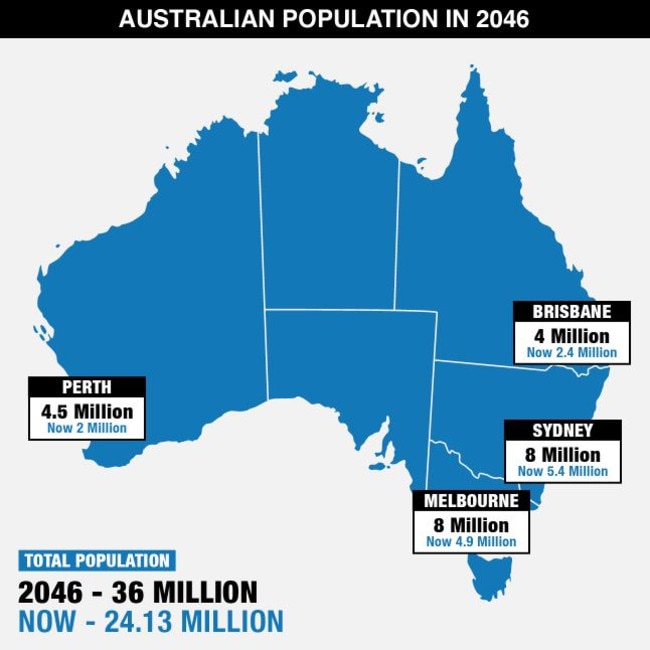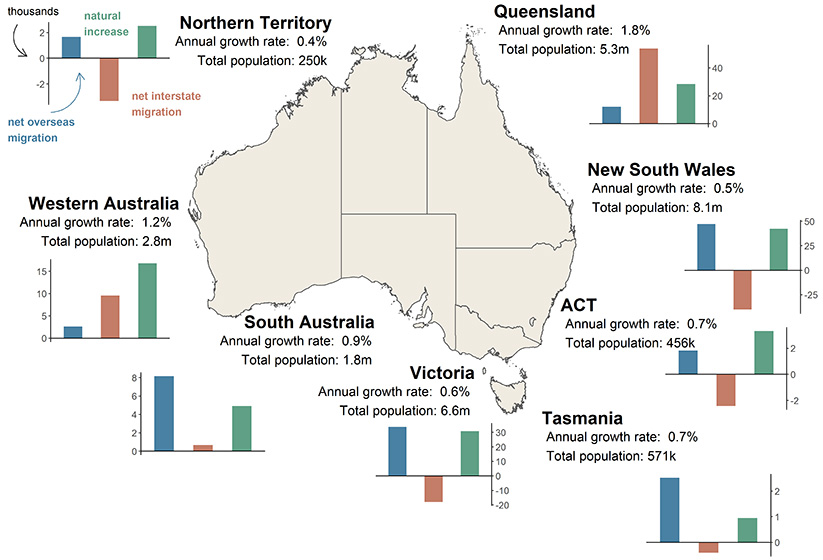Have you ever wondered why Australia, a continent larger than the continental United States, has a population that mostly clusters around the coast? A quick glance at an Australian population map reveals a fascinating story of human settlements shaped by geography, climate, and historical events. This journey through the “land down under” will illuminate the distribution of its population, unraveling the factors that contribute to its unique demographic landscape.

Image:
Understanding the distribution of Australia’s population is crucial for various reasons. It informs government planning related to infrastructure, services, and resource allocation. Businesses use this information to determine market potential and target customers effectively. For individuals interested in migrating or exploring Australia, having a clear grasp of its population density can provide valuable insights about lifestyle choices, economic opportunities, and access to resources.
Mapping Australia’s Population: A Story of Coastlines and Cities
Australia’s population map clearly showcases a distinct pattern: a concentration of people along the coastline, particularly in the southeastern and southwestern regions. This phenomenon is primarily driven by the country’s climate. The coastal areas, blessed with moderate temperatures and a higher rainfall, offer more hospitable conditions compared to the stark interior. Major cities, like Sydney, Melbourne, Brisbane, Perth, and Adelaide, act as magnets for population growth, attracting opportunities for employment, education, and cultural experiences.

The Interior’s Sparse Population: Challenges and Opportunities
The vast interior of Australia, often referred to as “the outback,” presents a drastically different picture. Sparsely populated, it’s dominated by arid and semi-arid landscapes. While the outback holds immense natural beauty, harsh conditions, including extreme temperatures, limited water resources, and isolated communities, discourage large-scale settlements.
Despite the challenges, the outback is not devoid of human presence. A small but resilient population resides there, embracing a unique lifestyle adapted to the environment. Mining, agriculture, and tourism contribute to the economy of this region.
Urban and Rural Dynamics: Balancing the Scales
The stark contrast between the densely populated coastal areas and the sparsely populated interior highlights a crucial dynamic in Australian society: the urban-rural divide. This divide manifests in various aspects, including access to services, economic opportunities, and social infrastructure.
The Australian government has implemented policies aimed at addressing the challenges faced by rural communities, including financial incentives for businesses, support for infrastructure development, and programs to attract skilled labor. These initiatives aim to ensure that the benefits of economic growth reach beyond the major cities and contribute to the well-being of rural regions.

Image:
Migration and Population Growth: Shaping Australia’s Future
Australia has a long history of embracing immigration as a key driver of economic growth and cultural diversity. Over the years, waves of migrants from various countries have settled in Australia, contributing to its vibrant multicultural fabric. This continuous influx of new residents has played a significant role in shaping the country’s population distribution, particularly in cities like Sydney and Melbourne, which have experienced substantial growth.
However, this growth is not without its challenges. As the population increases, putting pressure on resources like water, energy, and housing, the government faces the challenge of managing these demands sustainably while ensuring the well-being of all citizens.
The Future of Australia’s Population: Trends and Projections
Looking towards the future, demographic trends suggest that Australia’s population will continue to grow, driven by factors like immigration, a rising life expectancy, and a modest increase in birth rates. Projections by the Australian Bureau of Statistics indicate that the population could reach 40 million by 2050.
This growth will present both opportunities and challenges. It will necessitate smart planning to ensure housing affordability, efficient transportation, access to quality healthcare, and sustainable resource management. It also highlights the need for ongoing investment in infrastructure, education, and healthcare to cater to the needs of a growing citizenry.
Australia Population Map
Explore the Map, Discover the Stories
The Australian population map is more than just a visual representation of numbers. It tells a rich tapestry of stories about human resilience, adaptability, and the dynamic interaction between people and their environment. From the bustling coastal cities to the remote communities of the outback, each point on the map reflects the journeys, experiences, and aspirations of the diverse population that call Australia home.
As you study this map, consider the factors that have shaped the distribution of people across the continent. Imagine the lives and stories of individuals who have chosen to make this land their own. This journey of discovery will unveil the fascinating story of Australia’s population and its dynamic landscape.
Remember, the Australian population map is constantly evolving. As the country experiences shifts in migration patterns, urban development, and economic activities, the map will continue to reflect these changes. It offers a valuable window into understanding the present, anticipating the future, and appreciating the unique character of this diverse and resilient nation.





